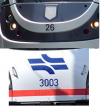Thoughts given rise to, by a thread on another board: I've wondered at times, how it has come about that Far Eastern nations, which write their languages in essentially non-alphabetic scripts, dealing largely in ideograms; nonetheless employ for locomotive classification, Roman alphabetic letters? This is done in China (with steam locos, usually a pair of Roman letters -- QJ, SY, etc. -- Roman letters also used, I understand, in respect of diesel and electric motive power). Japan does similarly, though in a different mode -- combining Roman letters and numerals. South Korea too -- though once again, if I understand rightly, on a different principle: the country's steam in latter days having mostly featured 2-8-2s, these were designated MK [Mikado] plus an identifying number to distinguish between classes. (I don't know what North Korea does, re this issue.)
While this convention on the part of the Orient's nations must be a mercy for railway enthusiasts from parts of the world which use alphabets -- making life a good deal less difficult for them, than might have been the case; it has at times seemed a little odd to me that the nations of the Far East have not used their own writing systems for this particular purpose. Would be interested in information / thoughts from anyone, on this matter. Is it simply that essentially, the Western nations invented and created railways first: subsequently giving the idea, at any rate, to the East -- hence the nations there latching on from the first, for this purpose, to Western writing "characters", and this situation continuing to obtain; or might there be other reasons for this (admittedly unimportant, in the general scheme of things) oddity?
While this convention on the part of the Orient's nations must be a mercy for railway enthusiasts from parts of the world which use alphabets -- making life a good deal less difficult for them, than might have been the case; it has at times seemed a little odd to me that the nations of the Far East have not used their own writing systems for this particular purpose. Would be interested in information / thoughts from anyone, on this matter. Is it simply that essentially, the Western nations invented and created railways first: subsequently giving the idea, at any rate, to the East -- hence the nations there latching on from the first, for this purpose, to Western writing "characters", and this situation continuing to obtain; or might there be other reasons for this (admittedly unimportant, in the general scheme of things) oddity?


